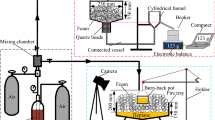Abstract
An experimental program was conducted to assess the firefighting capabilities (extinguishment and burnback times) of five commercially available, Underwriters Laboratories listed (UL 162) fluorine-free foams (FFFs) [three alcohol resistant (AR) and two hydrocarbon approved (H)] and one short chain C6 aqueous film forming foam (AFFF) formulation (for baseline) as a function of application rate (gpm/ft2) and foam discharge density (gal/ft2) for a range of test parameters including foam quality/aspiration (air-aspirated and non-air-aspirated), fuel type [heptane, gasoline (MIL-SPEC and E10), and IPA], water type (fresh and salt) and fuel temperature (ambient and elevated). To summarize the results, the baseline C6 AR-AFFF demonstrated consistent/superior firefighting capabilities throughout the entire test program under all test conditions and test fuels. The FFFs did well against heptane but struggled against some of the scenarios conducted with IPA and gasoline (both MIL-SPEC and E10), especially when the foam was discharged with a lower foam quality/aspiration. From an application rate perspective, the FFFs typically required between 1.5 and 3 times the application rates to produce a comparable performance as the baseline AR-AFFF for the range of parameters included in this assessment. From an extinguishment density perspective, the extinguishment densities for the FFFs were typically 2–7 times greater than the baseline AR-AFFF and were determined to be both manufacturer and fuel type dependent. The three major findings of the study include: foam quality/aspiration effects on the firefighting capabilities of FFFs, variations in extinguishment difficulty associated with fuel type and variations in capabilities between listed FFFs in general.





Similar content being viewed by others
Change history
13 February 2021
A Correction to this paper has been published: https://doi.org/10.1007/s10694-021-01099-w
References
NFPA 11 (2016) Standard for low-, medium-, and high-expansion foam, 2016 edn
UL 162 (2018) Standard foam equipment and liquid concentrates, 8th edn
MIL-SPEC (1992) US military specification, Mil-F-24385F. Department of the Navy, Washington
Scheffey JL, Wright JA (1994) Analysis of test criteria for specifying foam firefighting agents for aircraft rescue and firefighting. FAA technical report, DOT/FAA/CT-94/04, Atlantic City
Author information
Authors and Affiliations
Corresponding author
Rights and permissions
About this article
Cite this article
Back, G.G. An Evaluation of the Firefighting Effectiveness of Fluorine-Free Foams. Fire Technol 59, 3107–3116 (2023). https://doi.org/10.1007/s10694-020-01051-4
Received:
Accepted:
Published:
Issue Date:
DOI: https://doi.org/10.1007/s10694-020-01051-4




